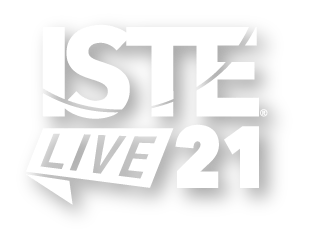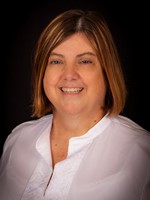

Do You Compute With Physical Devices? (3-5) |
Explore and create : Creation lab
Brenda Bass Laurie Green
Learn the definition of physical computing, its benefits in the classroom and supportive research. Methods for evaluating physical devices to determine appropriateness for integration within their curriculum will be shared. Attendees will rotate through hands-on stations to experience a variety of physical devices and apply evaluation techniques.
| Audience: | Library media specialists, Teachers, Technology coordinators/facilitators |
| Skill level: | Beginner |
| Attendee devices: | Devices useful |
| Attendee device specification: | Laptop: Chromebook, Mac, PC |
| Participant accounts, software and other materials: | Scratch - create account and bookmark MeetEdison- Bookmark MakeCode - create account and bookmark Sphero - create account and bookmark Sam Labs -download Little Bits- Code Jumper Kibo- |
| Topic: | Computer science & computational thinking |
| Grade level: | 3-5 |
| Subject area: | Computer science, STEM/STEAM |
| ISTE Standards: | For Educators: Designer
Computational Thinker
|
Purpose: The purpose of this session is to expose and immerse Educators to the advantages that Physical Computing brings to the classroom and how it can be leveraged to address equity issues for all learners.
Objectives:
Participants will be able to:
-explain physical computing
-identify and integrate computer science concepts with physical computing
-will be able to design and construct a learning environment that integrates physical computing that is equitable to all learners.
- identify opportunities in the curriculum to integrate physical computing experiences
-evaluate and choose appropriate physical computing resources to integrate within their curriculum.
-locate and identify physical computing resources including supportive literature and classroom ideas.
-leave with a framework developed during the session to support implementation when they return to their classroom.
The following educational challenges will be addressed;
-means for providing an equitable learning opportunity for all learners.
-active and engaged learning
-approaches to integrate computational thinking within the curriculum
-A wide variety of physical computing resources will be available to the participants to explore. Included are ways to adapt devices as assistive technology and also introduction to lesser known devices such as Kibo, and Code Jumper (designed for visually impaired)
Physical Computing models the theory of Constructionism as students gain an intrinsic comprehension of the interaction of physical devices with the world around them and apply that knowledge to problem solving.
Participants will have access to a Google Site where all lesson plans, activities, grant resources, and session materials will be located.
Audience participation and engagement will inform evidence of success during the sesion.
Sustained evidence of success will be evidenced by analyzing Google Analytics for long term activity after the session related to the Google Site shared.
Time: 10 minutes
Process: Device Based, Peer to Peer Interaction.. Icebreaker in which participants fill out a Google Form that populates an interactive map that will be projected on the screen, that places a marker where participants are from, and what they teach. This will be used to encourage peer to peer interaction as they learn about the other educators in attendance.
Welcome
Introduction of Facilitators
Overview of Workshop
Objectives and Goals
Audience Introduction
The audience introduction activity is interactive. Participants will be asked to fill out a
Google form prior to/during the first 3 minutes of the session. This form is linked to a Google Map. When participants fill out the form (first name, city/state where they teach, and grade level/subject area) it populates the map with markers. The Marker is their name, the marker is placed on the city and state they entered, and the associated information with the marker is the information they entered about themselves.
What is Physical Computing?
Time: 20 minutes
Process: Modeling and Physical Computing,
The definition of Physical Computing will be introduced from our robot Dash.
Video of Physical Computing in action in classrooms |variety of subject areas
Discussion-Connecting with your curriculum
Evaluating Physical Computing Resources. What to look for, and alignment | integration within your curriculum. Hand out forms.
Break into pairs using the map to find teacher with the same or similar grade level/subject area.
Rotation Stations
Time: 40 Minutes
Process: Peer to Peer interaction, Device Based Activities
-Explore and evaluate 4 Physical Computing Resources
- Participants will use the evaluation form discussed in the section before.
-10 stations will be set up, each with a different Physical Computing Resource
along with a prompt for an easy intro activity. Some stations may be duplicated based on attendance to meet demand. Laminated information cards will be at each station with bullet points of key features, concepts and possible integration ideas.
-Pairs may choose resources that look interesting and may have applicability in their classroom
-Participants will explore, discuss and evaluate
-Participants will rotate approx every 10 minutes to a resource of interest to explore
further. Laminated information cards will be at each station with bullet points of key
Features, concepts and possible integration ideas.
Regroup
Time: 20 minutes
Process: Peer to Peer, Modeling, Digital sharing, Question and Answer
-The Spike Robot will be programmed to move about the room sounding an alarm and flashing a light indicating it is time to wrap up and regroup
-share briefly findings, experience, reactions.
-resources for integration and funding ideas including grant opportunities will be shared
-Participants will work on a moving forward planner that will be distributed by a robot.
-Regroup and share moving forward ideas
-Final wrap up- review of key points
-Share Google site with all the resources
-Participants fill out exit ticket
Schulz, Sandra, and Niels Pinkwart. “Physical Computing in STEM Education.” Proceedings of the Workshop in Primary and Secondary Computing Education on ZZZ - WiPSCE '15, 2015, doi:10.1145/2818314.2818327.
Atman Uslu, Nilüfer, and Yasemin Koçak Usluel. “Predicting Technology Integration Based on a Conceptual Framework for ICT Use in Education.” Hellenic Journal of STEM Education, vol. 1, no. 1, 9 Oct. 2019, pp. 1–15, www.researchgate.net/publication/340266590_A_Conceptual_Framework_for_Computational_Pedagogy_in_STEAM_education_Determinants_and_perspectives, 10.1080/1475939x.2019.1668293. Accessed 26 Oct. 2019.
Csizmadia, Andrew, et al. “Integrating the Constructionist Learning Theory with Computational Thinking Classroom Activities.” Informatics in Education, vol. 18, no. 1, 2019, pp. 41–67., doi:10.15388/infedu.2019.03.
Przybylla, Mareen, and Ralf Romeike. “Physical Computing and Its Scope - Towards a Constructionist Computer Science Curriculum with Physical Computing.” Informatics in Education, vol. 13, no. 2, 2014, pp. 225–240., doi:10.15388/infedu.2014.14.
Wangenheim, Aldo Von, et al. “Motivating Teachers to Teach Computing in Middle School ‑ A Case Study of a Physical Computing Taster Workshop for K-12 Teachers.” International Journal of Computer Science Education in Schools, vol. 1, no. 4, 2017, pp. 35–49., doi:10.21585/ijcses.v1i4.17.
https://www.edweek.org/ew/articles/2019/01/23/physical-computing-connects-computer-science-with-hands-on.html
https://www.vernier.com/2019/04/22/how-physical-computing-can-help-your-elementary-and-middle-school-students/
https://www.iste.org/explore/Computer-Science/Make-CS-accessible-to-all-students-with-physical-computing

Brenda Bass works for BootUp as a Professional Development Facilitator partnering with school districts across the US to train/support elementary teachers to implement coding in their classroom. She is a retired teacher with over 30 years of teaching experience, most recently as the STEAM Lab Teacher in Texas where she taught K-5 coding, STEAM challenges and physical computing to support science standards. She was also the robotics sponsor. Prior to the Lab, she was a Digital Learning Specialist supporting multiple campuses with technology integration, facilitating Professional Development and supporting coding clubs. Brenda has presented at TCEA and ISTE.

Let the Games Begin! Play With Interactive Videoconferencing PLN
Resources for Teaching Artificial Intelligence and Algorithmic Thinking: Devices, Modules, Permissions, Games
Using Machine Learning as a Way to Think About Cognitive Bias